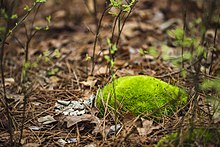
Back Moose ALS نباتات طحلبية Arabic نباتات طحلبيه ARZ Yarpaqlı mamırlar (şöbə) Azerbaijani Мохападобныя Byelorussian Мъхове Bulgarian ব্রায়োফাইটা Bengali/Bangla Mahovine BS Briòfits en sentit ampli Catalan Lumot CEB


Bryophytes (/ˈbraɪ.əˌfaɪts/)[1] are a group of land plants (embryophytes), sometimes treated as a taxonomic division, that contains three groups of non-vascular land plants: the liverworts, hornworts, and mosses.[2] In the strict sense, the division Bryophyta consists of the mosses only. Bryophytes are characteristically limited in size and prefer moist habitats although some species can survive in drier environments.[3] The bryophytes consist of about 20,000 plant species.[4][5] Bryophytes produce enclosed reproductive structures (gametangia and sporangia), but they do not produce flowers or seeds. They reproduce sexually by spores and asexually by fragmentation or the production of gemmae.[6]
Though bryophytes were considered a paraphyletic group in recent years, almost all of the most recent phylogenetic evidence supports the monophyly of this group, as originally classified by Wilhelm Schimper in 1879.[7]
The term bryophyte comes from Ancient Greek βρύον (brúon) 'tree moss, liverwort' and φυτόν (phutón) 'plant'.
- ^ "bryophyte". Dictionary.com Unabridged (Online). n.d.
- ^ Hedges, S. Blair (November 2002). "The origin and evolution of model organisms". Nature Reviews Genetics. 3 (11): 838–849. doi:10.1038/nrg929. PMID 12415314. S2CID 10956647.
- ^ Levetin, Estelle; McMahon, Karen (2012). Plants and Society. New York, NY: McGraw-Hill. p. 139. ISBN 978-0-07-352422-1.
- ^ "Bryophytes (Mosses and liverworts) — The Plant List". theplantlist.org. Retrieved 2017-04-11.
- ^ "What are Bryophytes". Southern Illinois University Carbondale. Archived from the original on 2018-10-19. Retrieved 2009-05-31.
- ^ Vanderpoorten, Alain; Goffinet, Bernard (2009). Introduction to Bryophytes. Cambridge: Cambridge University Press. p. 3. ISBN 978-0-511-54013-4.
- ^ Schimper, W.P. (1879). "Bryophyta". In Zittel, K.A. (ed.). Handbuch der Palaeontologie. Vol. 2. R. Oldenbourg.